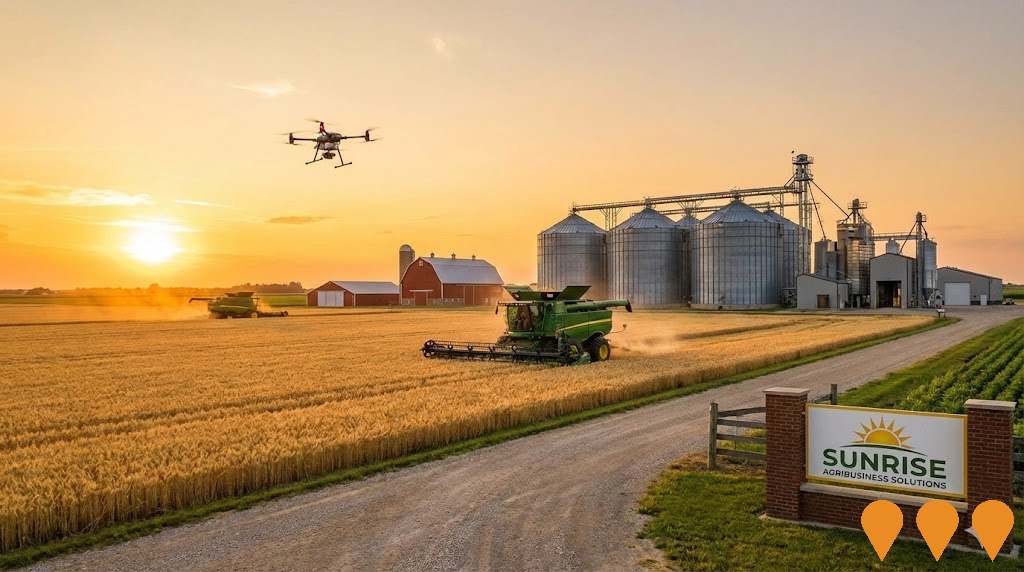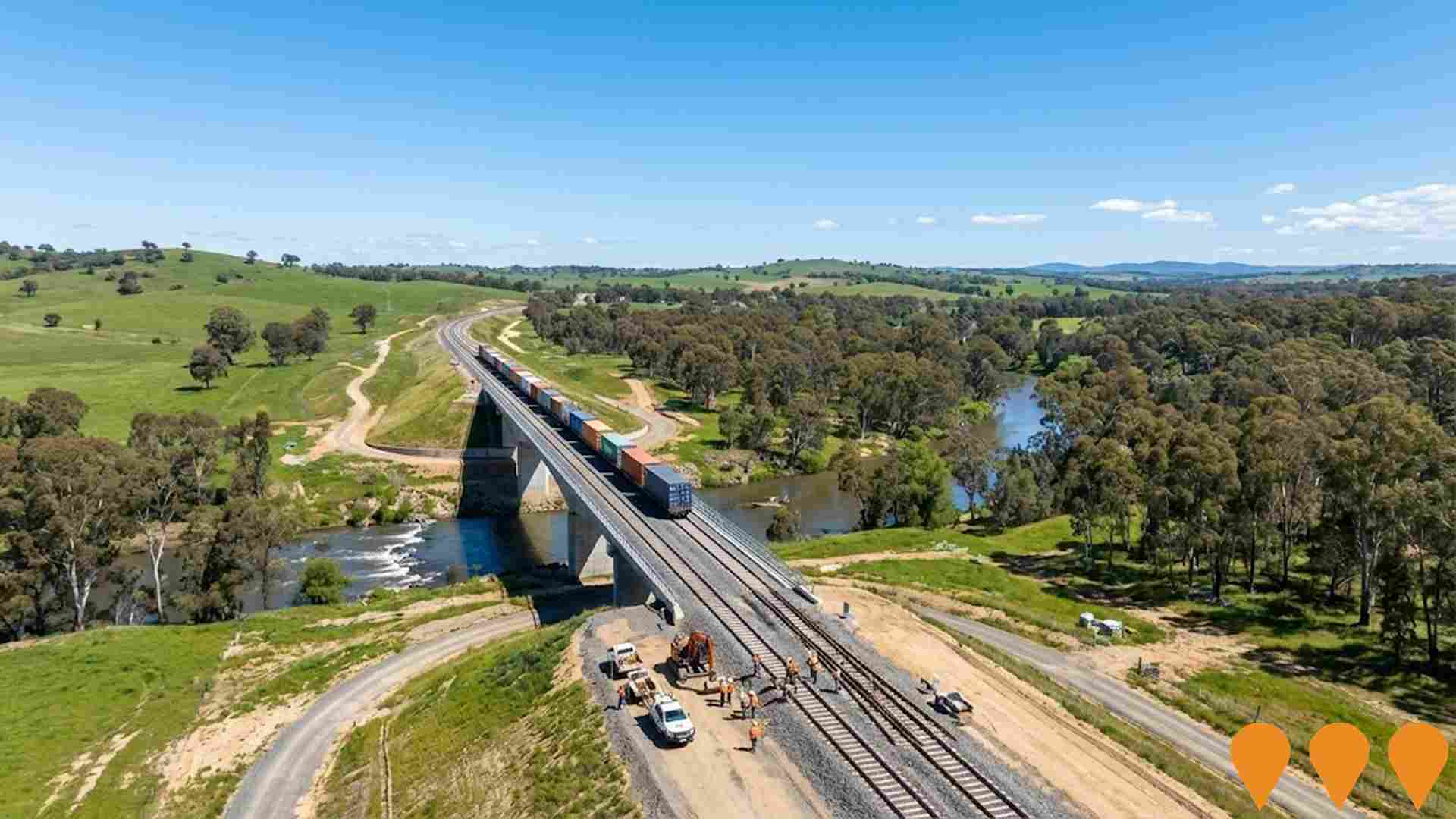Chart Color Schemes
est. as @ -- *
ABS ERP | -- people | --
2021 Census | -- people
Sales Activity
Curious about local property values? Filter the chart to assess the volume and appreciation (including resales) trends and regional comparisons, or scroll to the map below view this information at an individual property level.
Find a Recent Sale
Sales Detail
Population
Chiltern - Indigo Valley has seen population growth performance typically on par with national averages when looking at short and medium term trends
Chiltern-Indigo Valley's population was 3,184 as of August 2021. By June 2024, it had increased to an estimated 3,267. This reflects a growth of 83 people since the census, with interstate migration contributing approximately 65.8% of this increase. The population density is 6.4 persons per square kilometer. From 2021 to 2024, the area's population grew by 2.5%, close to the SA3 average of 3.6%. By 2041, the population is projected to reach 3,944, an increase of 760 persons and a total gain of 23.4% over the 17 years.
AreaSearch is adopting ABS/Geoscience Australia projections for each SA2 area, as released in 2024 with 2022 as the base year. For any SA2 areas not covered by this data, AreaSearch is utilising the VIC State Government's Regional/LGA projections released in 2023 with adjustments made employing a method of weighted aggregation of population growth from LGA to SA2 levels. Growth rates by age group from these aggregations are also applied across all areas for years 2032 to 2041. Moving forward with demographic trends, a significant population increase in the top quartile of locations outside of capital cities is forecast, with the area expected to expand by 760 persons to 2041 based on the latest population numbers, recording a gain of 23.4% in total over the 17 years.
Frequently Asked Questions - Population
Development
Residential development activity is lower than average in Chiltern - Indigo Valley according to AreaSearch's national comparison of local real estate markets
Chiltern - Indigo Valley has seen approximately 12 new homes approved each year over the past five financial years, totalling 62 homes. As of FY-26, six approvals have been recorded. On average, 1.9 new residents arrive per new home annually between FY-21 and FY-25, indicating balanced supply and demand with stable market conditions. New properties are constructed at an average cost of $451,000.
This financial year has seen $10.7 million in commercial development approvals, suggesting balanced commercial development activity. Compared to the rest of Victoria, Chiltern - Indigo Valley has around two-thirds the rate of new dwelling approvals per person and ranks among the 55th percentile nationally. Current building activity consists solely of detached houses, preserving the area's low-density nature and attracting space-seeking buyers.
With an estimated 490 people per dwelling approval, the development environment is quiet and low-activity. Population forecasts project a gain of 764 residents by 2041. If current development rates continue, housing supply may not keep pace with population growth, potentially increasing buyer competition and supporting stronger price growth.
Frequently Asked Questions - Development
Infrastructure
Chiltern - Indigo Valley has emerging levels of nearby infrastructure activity, ranking in the 24thth percentile nationally
Changes in local infrastructure significantly affect an area's performance. AreaSearch has identified six projects that could impact this region. Notable ones are Advanced Manufacturing Centre of Excellence, Wodonga Wastewater Treatment Plant Expansion, Hydrogen Park Murray Valley (HyP Murray Valley), and Wodonga Solar Farm. The following list highlights those likely to have the most relevance.
Professional plan users can use the search below to filter and access additional projects.
INFRASTRUCTURE SEARCH
 Denotes AI-based impression for illustrative purposes only, not to be taken as definitive under any circumstances. Please follow links and conduct other investigations from the project's source for actual imagery. Developers and project owners wishing us to use original imagery please Contact Us and we will do so.
Denotes AI-based impression for illustrative purposes only, not to be taken as definitive under any circumstances. Please follow links and conduct other investigations from the project's source for actual imagery. Developers and project owners wishing us to use original imagery please Contact Us and we will do so.
Frequently Asked Questions - Infrastructure
Hydrogen Park Murray Valley (HyP Murray Valley)
A 10 MW renewable hydrogen production facility using solar-powered electrolysis. Produces green hydrogen that is blended at up to 10% into the local Albury-Wodonga gas network, serving over 40,000 customers. Officially opened in September 2024 and now fully operational.
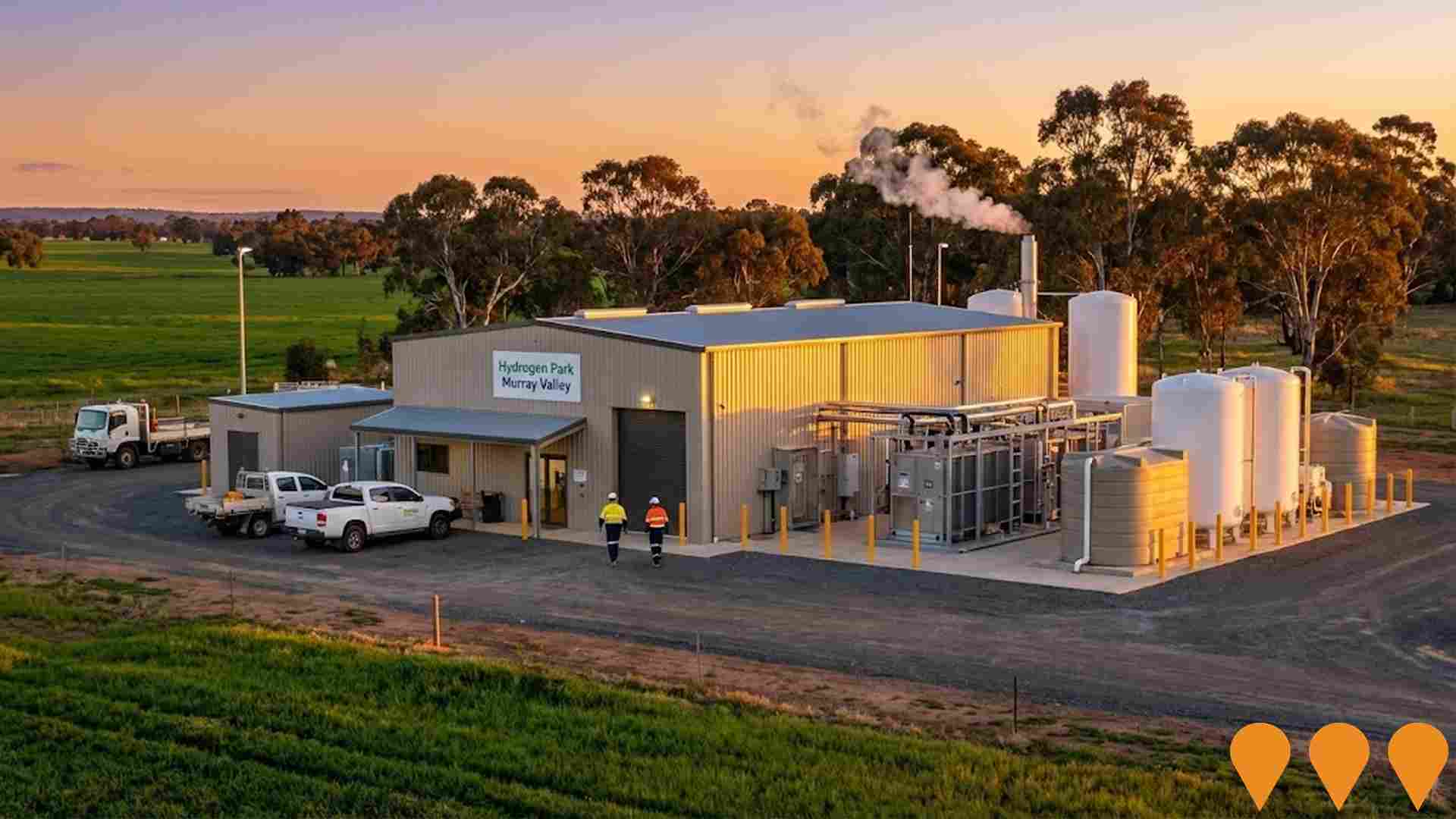
North East Rail Line Upgrade
Major upgrade to the North East Rail Line between Melbourne and Albury-Wodonga, improving freight and passenger services, including track resurfacing, mud-hole removal, drainage improvements, bridge upgrades, and signalling enhancements to allow VLocity trains and better ride quality.
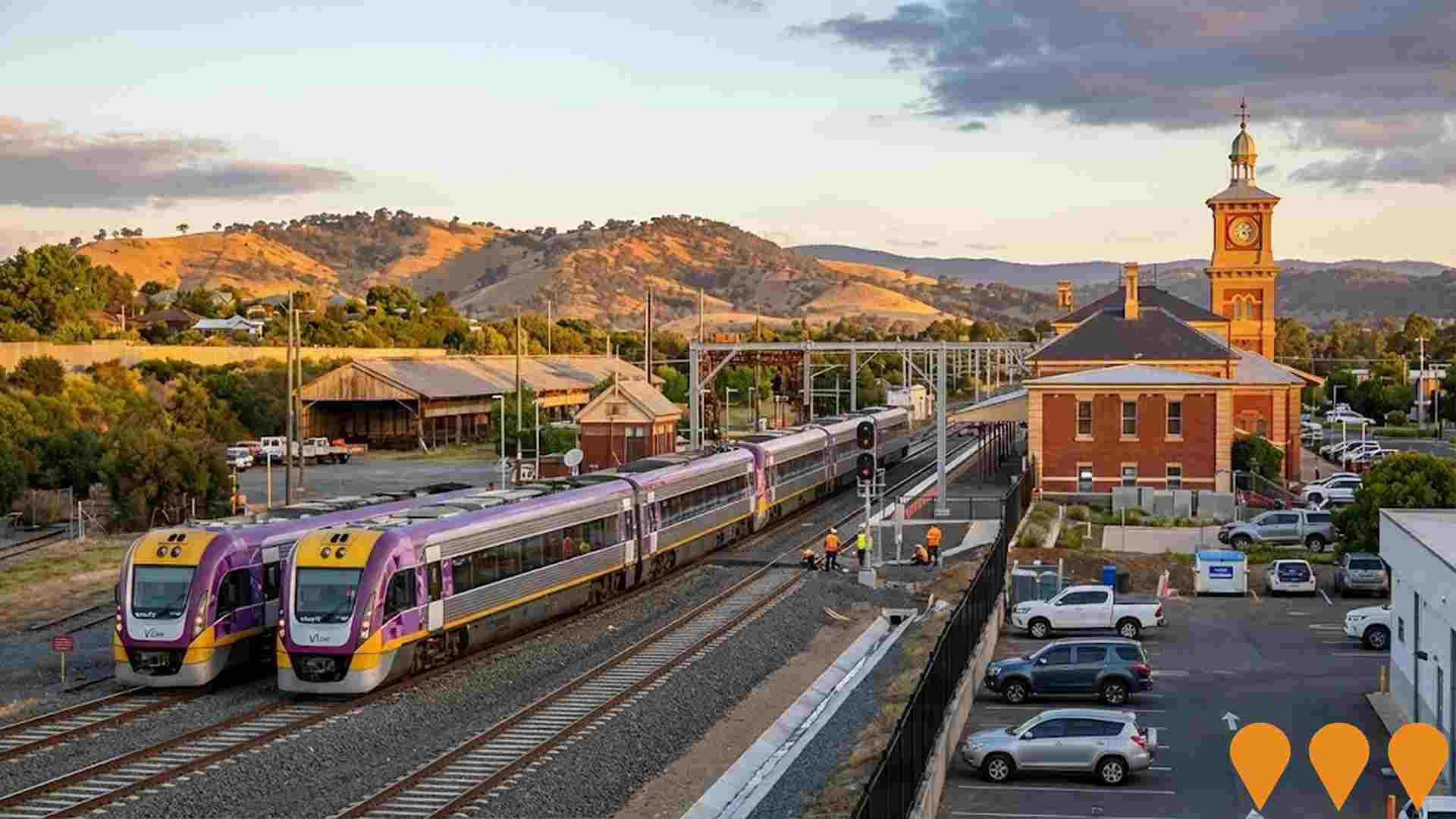
Victorian Renewable Energy Zones
VicGrid, a Victorian Government agency, is coordinating the planning and staged declaration of six proposed onshore Renewable Energy Zones (plus a Gippsland shoreline zone to support offshore wind). The 2025 Victorian Transmission Plan identifies the indicative REZ locations, access limits and the transmission works needed to connect new wind, solar and storage while minimising impacts on communities, Traditional Owners, agriculture and the environment. Each REZ will proceed through a statutory declaration and consultation process before competitive allocation of grid access to projects.
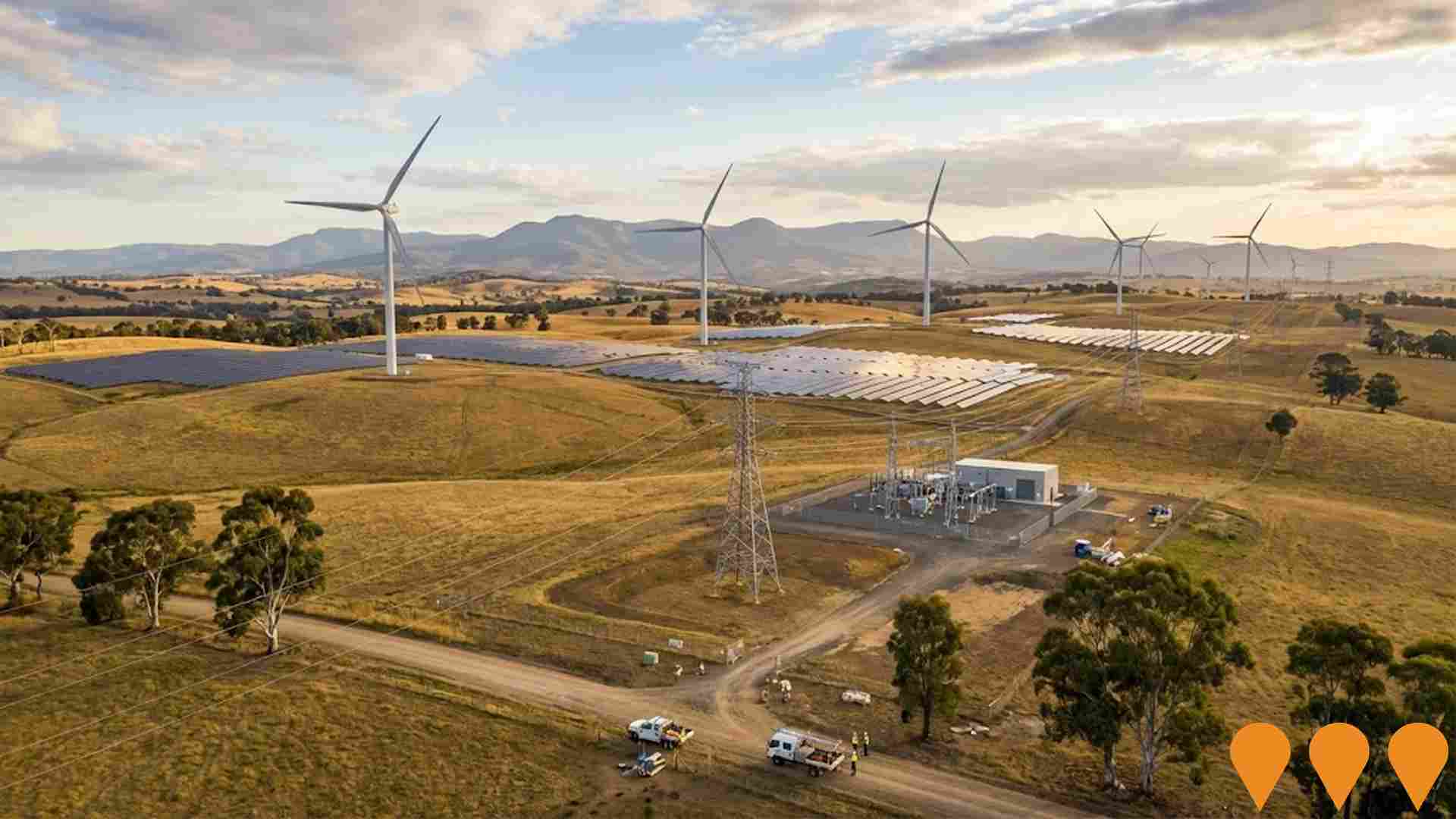
Wodonga Solar Farm
A completed 3 megawatt solar farm featuring 6,500 panels with single-axis tracking system, now powering the Wodonga Wastewater Treatment Plant with renewable energy. Operational since August 2023, the facility generates enough electricity to power the treatment plant during daylight hours with surplus energy fed back to the grid. The project reduces North East Water's carbon footprint by 6,000 tonnes of CO2 annually and contributes to the corporation's 100% renewable energy achievement.
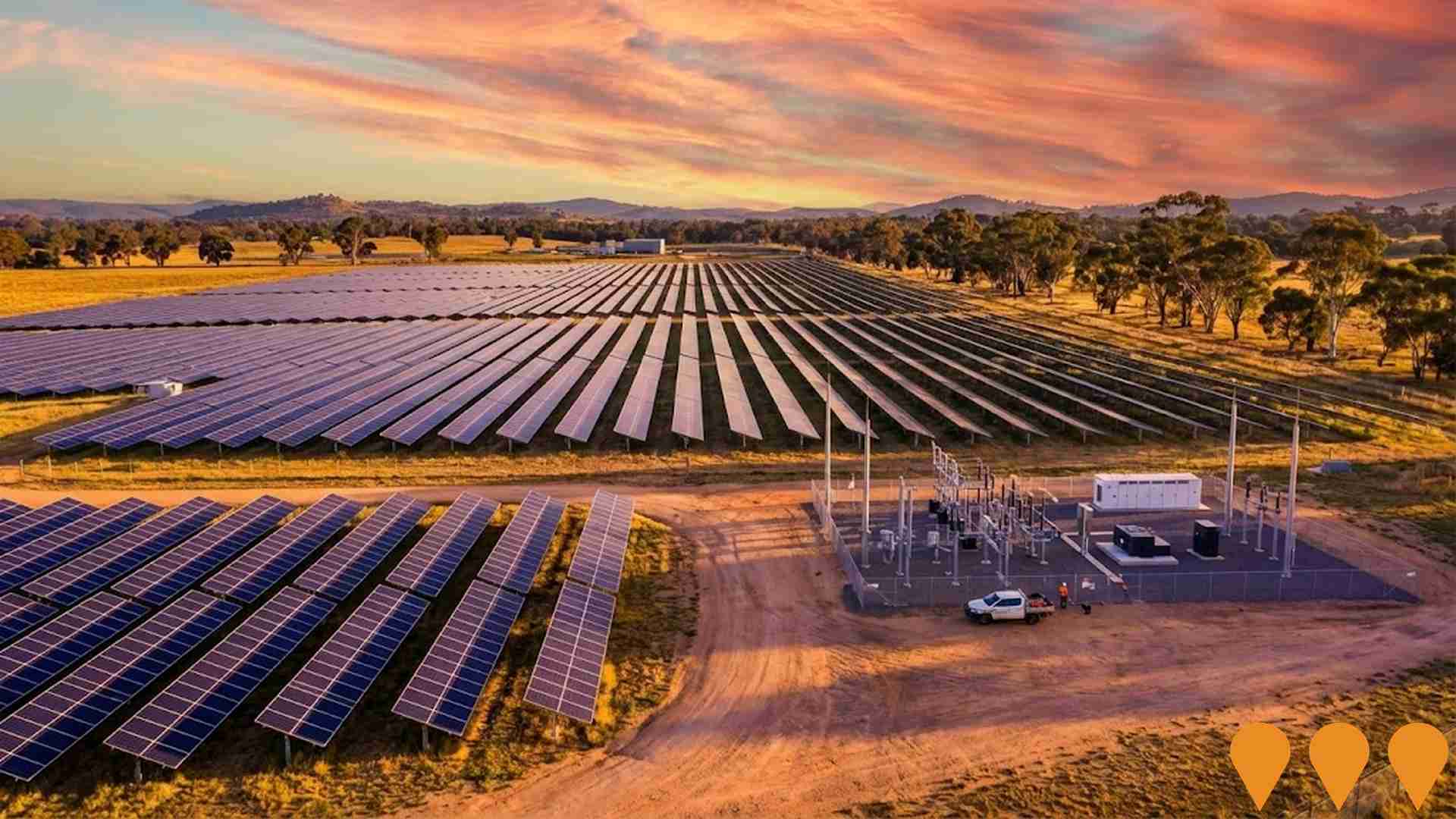
Albury Riverside Precinct
Public open space upgrade along the Murray River delivering an elevated all-abilities boardwalk to Bungambrawatha Creek, jetty and floating dock, river viewing points, BBQ and picnic facilities, shade structures, improved car parking, lighting, landscaping and new pathways linking Hovell Tree Park to the Albury Swim Centre. Project completed July 2023 with a total budget of approximately $8.7M.

VNI West (NSW section)
NSW portion of the VNI West interconnector: a proposed 500 kV double-circuit transmission line linking Transgrid's Dinawan Substation (near Coleambally) to the NSW/Victoria border north of Kerang, with associated upgrades including works on Transmission Line 51 near Wagga Wagga and expansion works at Dinawan Substation. The NSW Environmental Impact Statement (EIS) is on public exhibition in August 2025, and Transgrid has announced staged delivery with Stage 1 to Dinawan/South West REZ by early 2029 and Stage 2 to the Victorian border aligned to November 2030.
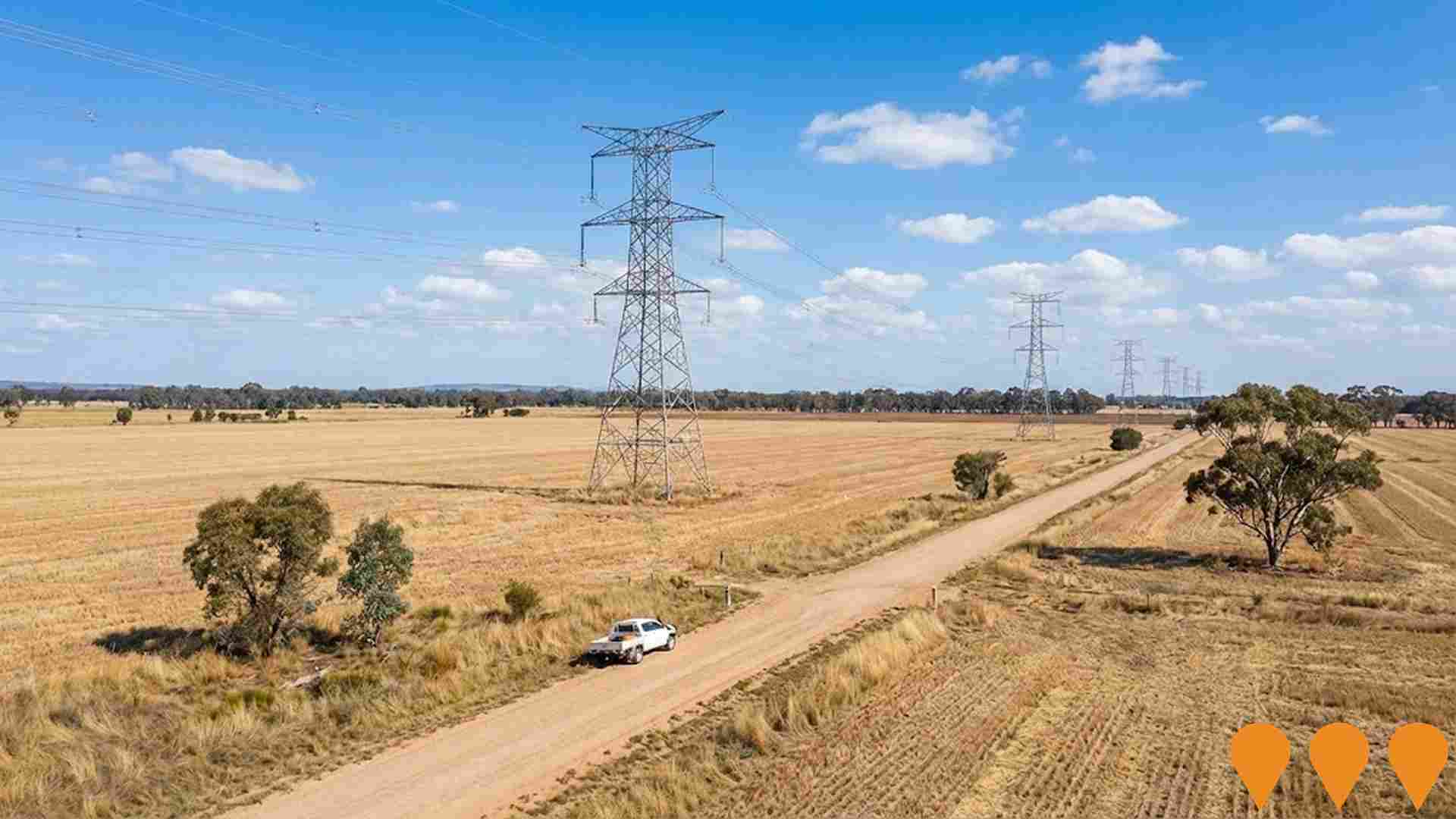
Wodonga Wastewater Treatment Plant Expansion
Major expansion of the wastewater treatment plant to double capacity from current levels to support Wodonga's growing population expected to reach 90,000 over 25 years. Features covered anaerobic lagoons for biogas recovery and renewable electricity generation, reducing emissions by 6,500 tonnes of CO2 annually. The upgrade enables more effective reuse of waste to generate energy that can be used on-site or fed back into the electricity grid, creating a self-sustaining facility.
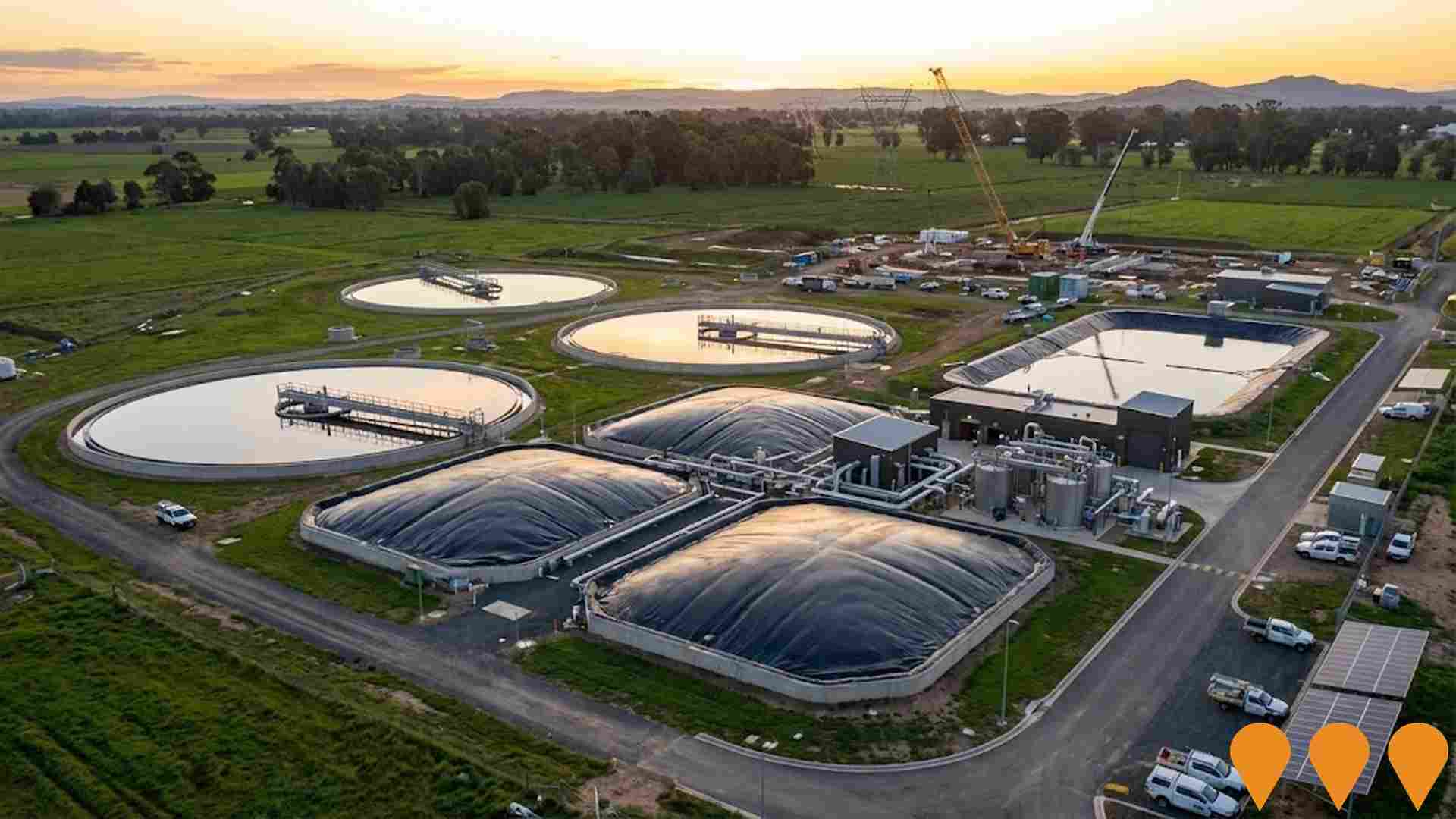
Inland Rail Beveridge to Albury
262km rail corridor upgrade enabling double-stacked freight trains between Beveridge and Albury. Two-tranche delivery with Tranche 1 under construction including bridge replacements and track modifications. John Holland contracted for Tranche 2.

Employment
The employment landscape in Chiltern - Indigo Valley shows performance that lags behind national averages across key labour market indicators
Chiltern-Indigo Valley has a balanced workforce with white and blue collar jobs. The unemployment rate is 4.3%.
Over the past year, employment stability is relative. As of June 2025, 1741 residents are employed while the unemployment rate is 4.4% compared to Rest of Vic.'s 3.8%. Workforce participation is 62.0%, slightly higher than Rest of Vic.'s 57.4%. Leading employment industries include health care & social assistance, manufacturing, and retail trade.
Manufacturing stands out with employment levels at 1.6 times the regional average. Construction employs 7.8% of local workers, lower than Rest of Vic.'s 10.4%. Employment opportunities locally may be limited based on Census data analysis. Between June 2024 and June 2025, employment increased by 0.4%, labour force by 1.4%, raising unemployment rate by 0.9 percentage points. Rest of Vic., however, saw employment decline by 0.9% and labour force decline by 0.4%. Jobs and Skills Australia's national employment forecasts from May 2025 suggest potential future demand in Chiltern-Indigo Valley. Over five years, national employment is forecast to expand by 6.6%, over ten years by 13.7%. Applying these projections to Chiltern-Indigo Valley's employment mix indicates local growth of approximately 5.7% over five years and 12.6% over ten years.
Frequently Asked Questions - Employment
Income
Income levels sit below national averages according to AreaSearch assessment
Chiltern-Indigo Valley had a median income of $48,880 among taxpayers and an average income of $57,865 in financial year 2022, according to ATO data aggregated by AreaSearch. These figures were lower than those for the Rest of Vic., which were $48,741 and $60,693 respectively. By September 2025, estimated median income would be approximately $54,824 and average income $64,901, based on a Wage Price Index growth of 12.16%. The 2021 Census showed household, family, and personal incomes in Chiltern-Indigo Valley ranked between the 35th and 39th percentiles. Income brackets indicated that 36.1% (1,177 individuals) earned between $1,500 and $2,999, consistent with broader regional trends of 30.3%. Housing costs were manageable, with 88.2% retained, but disposable income was below average at the 40th percentile. The area's SEIFA income ranking placed it in the 4th decile.
Frequently Asked Questions - Income
Housing
Chiltern - Indigo Valley is characterized by a predominantly suburban housing profile, with above-average rates of outright home ownership
In Chiltern - Indigo Valley, as per the latest Census evaluation, 94.9% of dwellings were houses, with the remaining 5.1% consisting of semi-detached properties, apartments, and other types. This is compared to Non-Metro Vic., which had 91.6% houses and 8.5% other dwellings. Home ownership in Chiltern - Indigo Valley stood at 43.1%, with mortgaged dwellings at 46.1% and rented ones at 10.8%. The median monthly mortgage repayment was $1,389, lower than Non-Metro Vic.'s average of $1,473. Weekly rent in the area was recorded at $260, compared to Non-Metro Vic.'s $280. Nationally, Chiltern - Indigo Valley's mortgage repayments were significantly lower at $1,389 than the Australian average of $1,863, and rents were substantially below the national figure of $375.
Frequently Asked Questions - Housing
Household Composition
Chiltern - Indigo Valley has a typical household mix, with a fairly typical median household size
Family households constitute 71.6% of all households, including 28.7% couples with children, 34.9% couples without children, and 6.7% single parent families. Non-family households comprise the remaining 28.4%, with lone person households at 26.3% and group households making up 2.5%. The median household size is 2.4 people, which aligns with the average for the Rest of Vic.
Frequently Asked Questions - Households
Local Schools & Education
Chiltern - Indigo Valley shows below-average educational performance compared to national benchmarks, though pockets of achievement exist
The area faces educational challenges, with university qualification rates at 18.6%, significantly below the VIC average of 33.4%. This presents both a challenge and an opportunity for targeted educational initiatives. Bachelor degrees are the most common at 12.2%, followed by graduate diplomas (3.7%) and postgraduate qualifications (2.7%). Trade and technical skills are prominent, with 43.2% of residents aged 15+ holding vocational credentials – advanced diplomas (11.2%) and certificates (32.0%).
Educational participation is high at 27.2%, including secondary education (9.7%), primary education (9.1%), and tertiary education (2.4%). Chiltern - Indigo Valley's 4 schools have a combined enrollment of 170 students, operating under typical Australian school conditions (ICSEA: 984) with balanced educational opportunities. The 4 schools focus exclusively on primary education, with secondary options available in surrounding areas. Local school capacity is limited at 5.2 places per 100 residents compared to the regional average of 17.6, leading many families to travel for schooling.
Frequently Asked Questions - Education
Schools Detail
Nearby Services & Amenities
Transport
Transport servicing is very low compared to other areas nationally based on assessment of service frequency, route connectivity and accessibility
Chiltern's public transport analysis shows four active stops in Indigo Valley offering a mix of train and bus services. These stops are served by five distinct routes that together facilitate 82 weekly passenger trips. Transport accessibility is deemed moderate, with residents generally situated 595 meters from the nearest stop.
Service frequency averages 11 trips per day across all routes, resulting in approximately 20 weekly trips per individual stop.
Frequently Asked Questions - Transport
Transport Stops Detail
Health
Health performance in Chiltern - Indigo Valley is well below average with prevalence of common health conditions notable across both younger and older age cohorts
Chiltern-Indigo Valley faces significant health challenges, with common conditions prevalent across both younger and older age groups. Approximately 49% (~1,595 people) have private health cover, lower than the national average of 55.3%.
The most common conditions are arthritis (10.8%) and mental health issues (9.6%). About 60.3% report no medical ailments, compared to 64.1% in Rest of Vic. The area has a higher proportion of residents aged 65 and over at 21.7% (708 people), compared to the Victorian average of 20.7%. Health outcomes among seniors present challenges but perform better than the general population in health metrics.
Frequently Asked Questions - Health
Cultural Diversity
The latest Census data sees Chiltern - Indigo Valley placing among the least culturally diverse areas in the country when compared across a range of language and cultural background related metrics
Chiltern-Indigo Valley had a cultural diversity below average, with 91.7% of its population being Australian citizens, 91.5% born in Australia, and 98.3% speaking English only at home. Christianity was the main religion, comprising 50.4% of the population, compared to 48.2% across Rest of Vic., as recorded on 30 June 2016. The top three ancestry groups were Australian (35.1%), English (32.6%), and Irish (9.8%).
Notably, Dutch (1.7%) was overrepresented compared to the regional average of 1.6%, German (4.4% vs 4.8%), and Hungarian (0.3% vs 0.2%).
Frequently Asked Questions - Diversity
Age
Chiltern - Indigo Valley hosts an older demographic, ranking in the top quartile nationwide
Chiltern-Indigo Valley has a median age of 46, which is slightly higher than the Rest of Vic's figure of 43 and significantly higher than the national norm of 38. The 55-64 age group shows strong representation at 16.8%, compared to Rest of Vic.'s figure, whereas the 25-34 cohort is less prevalent at 9.3%. This 55-64 concentration is well above the national average of 11.2%. Post-2021 Census data shows the 15 to 24 age group has grown from 10.2% to 12.1%, while the 45 to 54 cohort has declined from 15.2% to 13.8%, and the 5 to 14 group dropped from 11.5% to 10.3%. By 2041, Chiltern-Indigo Valley is expected to see notable shifts in its age composition. Leading this demographic shift, the 35-44 group will grow by 47%, adding 164 people to reach a total of 512 from 347. Meanwhile, the 15 to 24 cohort grows by a modest 7%, adding 29 people.
